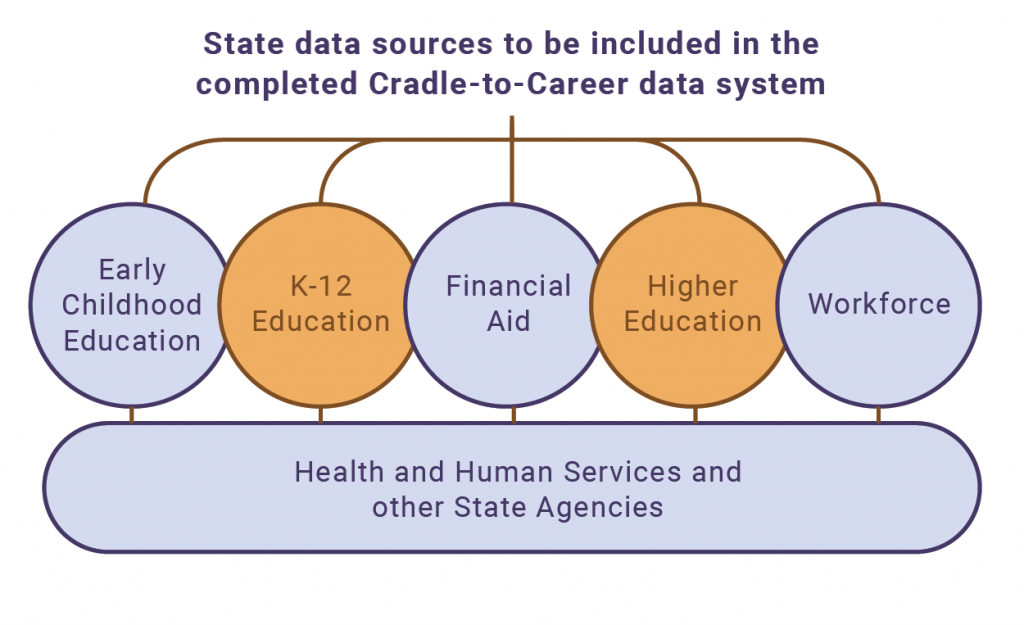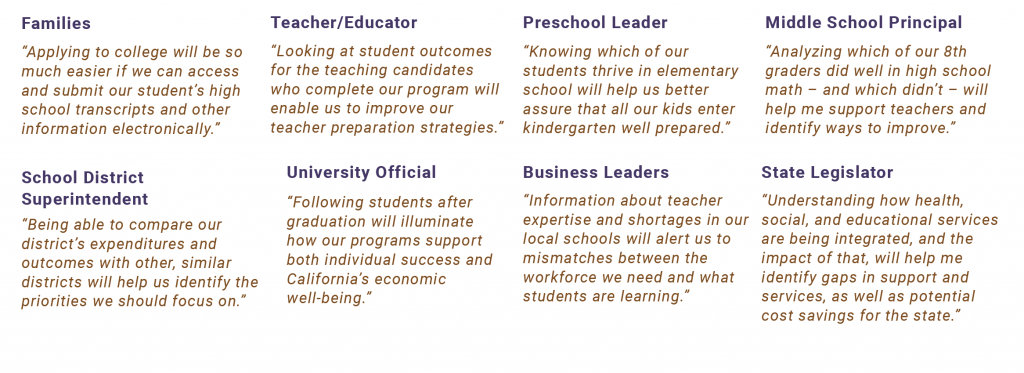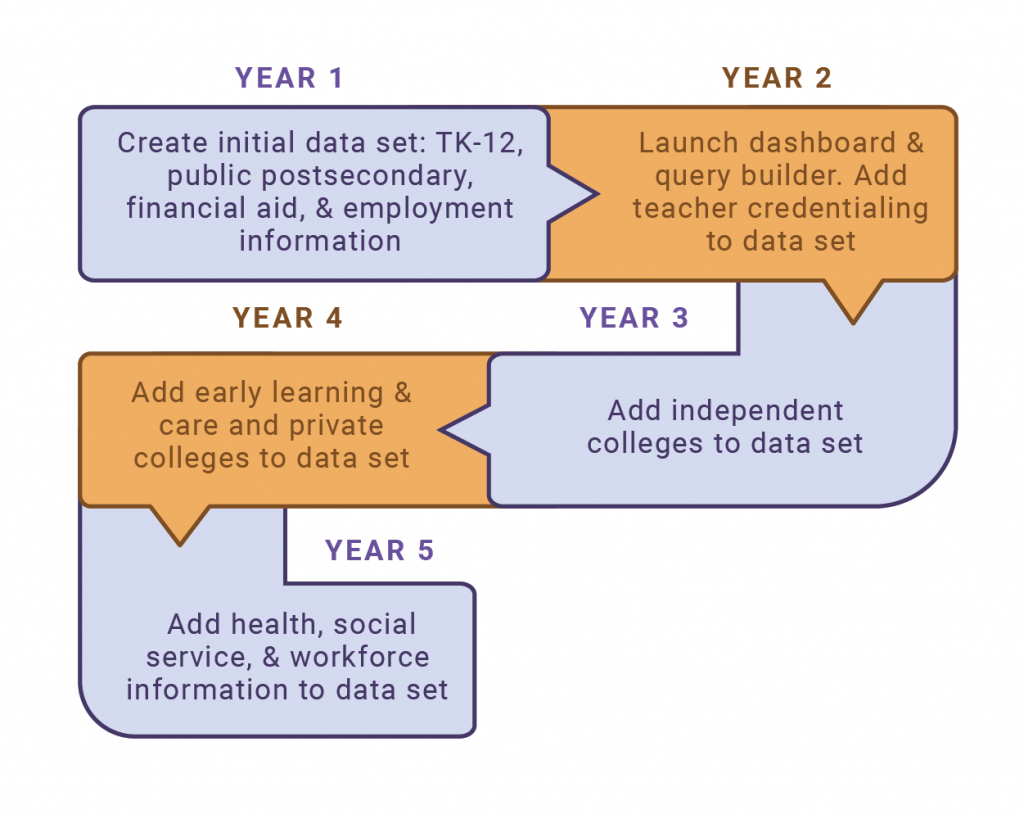A Q&A with Children Now’s Education Team
June 22, 2022
Top image via iStock from Wavebreakmedia
California’s students can attain the optimal and equitable opportunities for learning they deserve when parents, educators, and other professionals have the coherent information they need to do the best for students. Recognizing that, California is currently establishing a Cradle-to-Career Data System (C2C) that will enable the many government sectors that serve children – and the various stakeholders who play a part in their lives – to share appropriate information regarding those children, the conditions they experience, and the services they receive, as well as the continued educational and career paths they pursue. Read on to learn more about the C2C and how you can get involved to ensure that it does right by students in California.
What is California’s new Cradle-to-Career Data System?
California is in the process of creating the state’s first integrated early childhood through employment data system – the Cradle-to-Career Data System (C2C). When the C2C is fully operational, it will integrate an extraordinary array of information from education, workforce, and health and human service programs. Importantly, the C2C will NOT be a new data collection enterprise, but is instead building on the systems that already exist by initially connecting some 200 data points from 11 major sources of data collected by the State. For example, policymakers could link students’ CalWORKS status with financial aid application rates, and adjust policies to enhance access for students with greater need, as appropriate.

Who stands to benefit from the new system?
From its inception, the C2C has been developed with a wide range of users in mind. The goal of the system is to provide accessible, actionable data for students and their families, educators, researchers, advocates, policymakers, and the general public to inform their decision-making. To achieve this vision, the C2C will provide a variety of tools and resources. In fact, the C2C’s website already includes college planning and application tools that are being provided in partnership with CaliforniaColleges.edu and eTranscripts. In the coming months, the C2C will launch newly-created, statewide dashboards that generate answers to common questions, as well as query tools to allow stakeholders to explore data in greater depth. Community-sensitive outreach, training, and technical assistance also are planned, to promote awareness and understanding and to help ensure that all who might benefit from this information system will be able to do so effectively.
Diverse end-users will be able to find information within the Cradle-to-Career data system to help individual children as well as address broader issues of system improvement.

Who is contributing data and supporting the development of the new system?
Numerous entities will be contributing data to the C2C, including the Association of Independent California Colleges & Universities; Bureau for Private Postsecondary Education; California Community Colleges; California Department of Education; California Labor and Workforce Development Agency; California School Information Services; California Health and Human Services; California State University; California Student Aid Commission; California Commission on Teacher Credentialing; and the University of California. The diverse data collected and integrated by these entities range and could include entry age into early care, days of attendance in K-12, completion of certain courses in high school, application and admission to a four-year university, financial aid status, and participation in various occupations. The majority of these data points are broken down by gender, race, ethnicity, socio-economic status, and other factors. And the integration of these data can allow service providers, researchers, and policymakers to make the changes needed to enhance opportunities and outcomes for California children and youth.
Each of these data-contributing entities is represented on the C2C’s governing body, along with several legislative and gubernatorial appointees. In addition, two formal advisory committees – The Data & Tools Advisory Board and The Community Engagement Advisory Board – have been appointed to support the work of the C2C. Finally, a professional, full-time staff has been assembled to manage the daily operations of the C2C.
What is the timeline for development/implementation of the C2C?
Over the last four years, an extensive development process has been undertaken to lay the foundation for the creation of the C2C. This includes state policymakers making an investment in the initial planning process in the 2019-20 budget agreement; an 18-month-long engagement effort with the involvement of over 200 stakeholders from data contributing entities, researchers, advocates, and community groups to develop the vision and implementation plan for the C2C; the formal creation and funding of the C2C in the 2021-22 State Budget; and extensive work by all participating agencies to create guardrails that protect security and privacy for all as the system is built.
As part of the authorizing legislation, the State adopted a five-year plan for rolling out the C2C, from staffing the C2C office and refining objectives this year (Year One), through progressive integration of various education and labor data systems, to a full expansion that will allow stakeholders to understand the interrelationship between health, early care, educational, postsecondary, and workforce services that most effectively benefit kids across our state. The system will begin by linking K-12 and postsecondary data in Year Two, and will incorporate data on labor (Year Three), early care (Year Four), and health and social services (Year 5).

How can you get more involved?
The C2C has created numerous opportunities to get more involved. This includes broadcasting online community conversations, its advisory committee meetings, and its Governing Board meetings.
The C2C online community conversations provide a venue not only for all Californians to stay up-to-date on the system as it evolves, but also allows the public to be able directly convey what they – as a parent, teacher, community organizer, businessperson – need from a well-constructed data system and tools. Similarly, the advisory committee meetings are focused on ensuring that the system and its tools are built in ways that are accessible and meet community members’ needs. The public comment periods allow anyone to weigh in with their perspective.
Another critical way stakeholder groups can get involved is to promote and support efforts to build and strengthen the data systems that will be integrated into the C2C in the future. Initially, the C2C will only connect the various systems that exist. Many of those systems have room for improvement, so there is significant work to do to ensure each sector makes the changes needed to contribute high-quality data when it is ultimately integrated into the C2C. Organizations that will benefit from the C2C are encouraged to communicate their information needs directly to state agencies that manage their sectors’ programs. For example, planning and implementation efforts are underway at the California Department of Social Services (CDSS) to create an early childhood data system, referred to as the California Brilliant Beginnings Data Landscape. That data system will be essential in order to have a deeper understanding of the needs of our youngest Californians and the opportunities they have access to – and will eventually provide critical baseline data for children as they transition into TK-12 education. In addition, as Children Now noted in our brief, Robust Data Systems Needed for California’s Child Behavioral Health (2021), California has a long way to go to coherently provide the information necessary to effectively understand and support child mental health and wellness in the state. The more advanced and robust these systems become individually, the greater their impact can be on informing policy and service delivery once they are integrated into C2C.
Now is the optimal time to get directly involved in the C2C implementation efforts and ensure various data systems feeding into the C2C are robust. This is true for both members of the general public, and stakeholders in the broader landscape of organizations that serve California children and families. Involvement today can guide the C2C toward being a critical instrument for ensuring every California child’s needs are better met, so that they have the greatest opportunity to realize their potential.
Additional Resources:
Children Now C2C Brief (2020)
